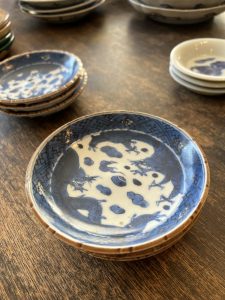ここから一気に年の瀬に向かいますね。(愛知県名古屋市千種区姫池通 骨董買取 古美術風光舎)
2023.12.26
みなさまこんにちは、スタッフYでございます。
クリスマスも昨日終わりましたね。みなさま、サンタさんから何かプレゼントは届きましたでしょうか。
私の今年のクリスマスプレゼントは先日お伝えした電子レンジ。喜びは少々薄めでしたが、あれから何事もなかったように我が家の生活に馴染んでおりまして、朝から「チーン、チーン」と、大活躍しております。来年はもうちょっと夢のあるプレゼントを頂きたいものです笑。

そんなクリスマスの余韻もままならないまま、今日からすでに街中が一気にお正月になり替わり、お正月飾りやお正月食材などが店頭に並んでおりました。日本の年末年始はなんと忙しいことか。
そういえば、今年は年賀状をいち早く仕上げました。そんなことをして何か起こるんじゃないかくらいありえないことなのですが、来年は「辰(龍)年」であります。
架空の動物ですので、年賀状の龍の表現も様々。さすがにこれといった正解はないようでして、これはセンスが問われますね。
それにしても、干支の中で辰(龍)だけが架空の動であることは周知の事実ではありますが、他の干支は実在する動物なのになぜ龍だけが架空の動物なのか?いつも不思議に思います。
これについてもはっきりとした理由はわかっていないようですが、「本来干支の各文字に動物は関係なかったのに、あとから同音の動物を紐づけたせいで架空の動物が入ってしまった」という説や、「龍という文字に鰐(ワニ)の意味もあったので、そもそもは龍ではなくワニを指していた」とする説などもあるようですね。
そもそも、龍とは中国の伝説に出てくる中国人にとって最も神聖な霊獣のことでして、なんと殷(「商」とも呼ばれる。BC17世紀~BC1046年)の時代の甲骨文字にはすでに「龍」の文字があるそうですから、ずいぶん古くからイメージ化されていたことがわかります。それから「龍」は伝説の霊獣は長い歴史の中で形も文化的な意味もさまざまに発展していきます。商や周(BC1046年~BC249年)の時代には龍は雷雨の神とされ、干ばつには龍を祀り雨ごいをするようになります。周の時代には龍は徳のシンボルになり、漢代(前漢BC206年~AD8年)以降になると皇帝龍生説が起こり、皇帝は龍によって生まれたという説がおこります。皇帝の子孫のことを「龍子龍孫」と言っていたようです。
その後、龍を吉兆と見るようにもなり「青龍」「白虎」「朱雀」「玄武」は「四霊(四種の霊獣)」と呼ばれ、四霊日本の高松塚古墳を思い出した方もらっしゃるのではないでしょうか。また、龍と鳳凰が同時に現れることを「龍鳳呈祥」と呼ばれるようにもなりました。また、唐代になると龍と鳳凰を結婚の象徴とすることが流行り、宋・元・明・清以には龍は皇帝の独占するところとなります。民間で龍の文様を使うことは禁じられ、漢や唐のころから龍は中華民族のシンボルにもなっていき、もはや権力の象徴ともなっていきます。
中国での龍の象徴の歴史も、どんどん上り龍のようになっていったようですね。
そんな龍ですが、弥生時代には現在の龍のモチーフが日本にもたらされております。和泉市にある紀元一世紀頃の池上曽根遺跡から、胴をくねらせ三角の無数の突起を持つ動物が描かれた壺が出土しておりまして、こうした弥生竜の図柄を持った遺物は、日本全国で30点あまり発見されております。となると、これら以前にはすでに龍は日本に上陸していたのでしょうか。
このように日本にも龍はすっかり浸透しておりますが、干支を広く浸透させるために古来より中国で権力の象徴とされ縁起の良い生き物として龍を仲間入りさせたのでしょうか。ですが、いつどこで龍が仲間入りしたのかはよくわかりませんでした。
それにしても、龍の姿はワニに似ていて、ワニこそ龍の起源ではないかと言われています。言われてみればそう見えなくもなく…。古代氏族社会のトーテム(特定の部族と宗教的に結びつけられた野生の動物や植物の象徴)崇拝の中でワニに神秘的・神奇的な力が与えられていったのではないかと言われており、西アジアや東ヨーロッパの一部の地域にも十二支の風習があるようでして、本来龍を指す「辰」に関していうと、アラビアでは辰がワニに置き換わっており、イランでは辰がクジラに置き換わっていたりして、その存在は架空の龍が先かワニが先かどちらになぞらえたのかはこちらも謎ではありますね。
ちなみに、イランの人々が日常でクジラを目にすることはほぼないそうですし、干支がいつどこでクジラに置き換わったのか、いろいろ笑えます。
干支の龍の謎は少しわかりましたが、私の今年の年賀状の龍はそんな歴史の重みもなくカラフルなかなりポップな龍になってしまいました。架空の動物とはいえ、こんなポップな姿になろうとは…3000年前の龍が想像していただろうか笑。
みなさま、龍と共に慶きお年をおむかえくださいませ。
それではごきげんよう。

Hello everyone, this is Staff Y.
Christmas was over yesterday. I hope you all received some presents from Santa Claus.
My Christmas present this year was the microwave oven I mentioned the other day. I was a little less pleased with it, but it has become a part of our home life as if nothing had happened since then, and it has been very active from morning “ding, ding, ding”. Next year, I would like to receive a more dreamy present.
While the afterglow of Christmas is still lingering in the air, the streets have already turned to New Year’s today, with New Year’s decorations and foods lined up in stores at once, and what a busy year-end and New Year’s season it is in Japan.
Come to think of it, I finished my New Year’s greeting cards as quickly as possible this year. It is so impossible that something might happen by doing so, but next year is the “Year of the Dragon (Ryu).
Since it is a fictitious animal, there are various expressions of dragons on New Year’s cards. As expected, there seems to be no correct answer, and this is a test of taste.
It is a well-known fact that the dragon is the only fictitious animal among the Chinese zodiac signs, but I always wonder why the dragon is the only fictitious animal while the other zodiac signs are real animals. I always wondered.
There is a theory that “Originally, there was no animal related to each letter of the Chinese zodiac, but later, a fictitious animal was included because of the connection of animals with the same sound” or “The character for dragon also had the meaning of crocodile, so it originally referred to a crocodile rather than a dragon. There is also a theory that the word “dragon” was originally used to refer to a crocodile, rather than a dragon.
The dragon is the most sacred spirit animal for the Chinese people in Chinese legends, and the word “dragon” is said to have already appeared in the bone script of the Shang Dynasty (17th century BC – 1046 BC), so it is clear that it has been imaged from a very long time ago.
Then, the “dragon” was a legendary spirit animal that developed in various forms and cultural meanings over its long history.
During the Shang and Zhou dynasties (1046 BC – 249 BC), dragons were regarded as gods of thunder and rain, and in times of drought, dragons were worshipped to ward off rain. During the Zhou dynasty, dragons became a symbol of virtue, and after the Han dynasty (206 BC – 8 AD), the theory that emperors were born of dragons arose. The descendants of emperors were referred to as “dragons and dragons’ descendants.
Later, dragons came to be seen as good omens, and the “Blue Dragon,” “White Tiger,” “Suzaku,” and “Xuanwu” were called the “Four Spirits,” and some of you may remember the Takamatsuzuka burial mound in Four Spirits Japan. The simultaneous appearance of a dragon and a phoenix also came to be known as the “dragon and phoenix presentation.
In the Tang dynasty, dragons and phoenixes became popular as symbols of marriage, and by the Song, Yuan, Ming, and Qing dynasties, dragons were the exclusive property of the emperors. The use of dragon patterns in the private sector was forbidden, and from the Han and Tang dynasties, dragons also became a symbol of the Chinese nation and no longer a symbol of power.
The history of dragon symbolism in China also seems to have become more and more like an ascending dragon.
Such dragons, however, were brought to Japan in the Yayoi period (710-794) with their current dragon motifs. At the Ikegamisone site in Izumi City, which dates back to the 1st century AD, a jar has been excavated that depicts a wriggling animal with a triangular body and numerous projections. Does this mean that dragons had already landed in Japan before the Yayoi period?
Nevertheless, the dragon looks like a crocodile, and it is said that the crocodile is the origin of the dragon. If you ask me, it doesn’t look that way…. It is said that the crocodile may have been given mystical and magical powers in the worship of totems (symbols of wild animals and plants religiously associated with specific tribes) in ancient tribal societies, and that there are also customs of the zodiac in some parts of Western Asia and Eastern Europe. In Arabia, the dragon has been replaced by a crocodile, and in Iran, the dragon has been replaced by a whale, and it is a mystery whether the existence of the dragon or the crocodile was compared to the imaginary dragon first.
Incidentally, Iranians almost never see whales in their daily lives, and it is funny in many ways when and where the Chinese zodiac was replaced by whales.
I now understand a little more about the mystery of the dragon in the Chinese zodiac, but the dragon on my New Year’s greeting card this year has no such historical significance and is a colorful and rather cute dragon. Even though it is a fictional animal, I never thought it would look this pop… I wonder if a dragon 3000 years ago would have imagined this lol.
I hope you all have a happy new year with dragons.
Have a good one.
*******************
ご実家の整理やお片付けなどをされている方のご相談などが多くございます。
お片付けなどくれぐれもご無理のないようになさってくださいませ。
風光舎では古美術品や骨董品の他にも絵画や宝石、趣味のお品など様々なジャンルのものを買受しております。
お片付けをされていて、こういうものでもいいのかしらと迷われているものでも、どうぞお気軽にご相談下さいませ。
また風光舎は、出張買取も強化しております。ご近所はもちろん、愛知県内、岐阜県、三重県その他の県へも出張いたします。
まずは、お電話お待ちしております。
愛知県名古屋市千種区姫池通
骨董 買取【古美術 風光舎 名古屋店】
TEL052(734)8444
10:00-18:00 OPEN
#出張買取#骨董#古美術#骨董品#絵画#版画#茶道具#刀剣#彫刻

